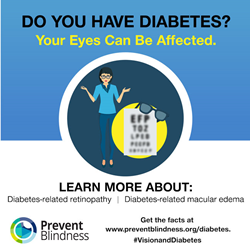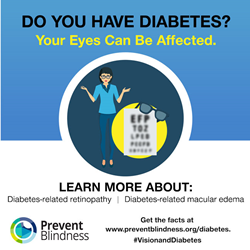
November declared as Diabetes-related Eye Disease Month by Prevent Blindness.
“Education, advocacy and access to care are key to helping to prevent vision loss from diabetes,” said Jeff Todd, president and CEO of Prevent Blindness.
CHICAGO (PRWEB)
October 27, 2020
Data from the Centers for Disease Control and Prevention (CDC) National Diabetes Statistics Report, 2020, shows that 34.2 million Americans have diabetes and 88 million American adults have prediabetes. Alarmingly, more people are developing type 1 and type 2 diabetes during youth, and racial and ethnic minorities continue to develop type 2 diabetes at higher rates. The CDC also states that diabetes is the leading cause of new cases of blindness in adults.
Because the longer someone has diabetes, the higher risk they face for developing vision issues, and health disparities continue to affect minority populations, Prevent Blindness, the nation’s oldest volunteer eye health non-profit organization, has declared November as Diabetes-related Eye Disease Month. Educational resources include downloadable factsheets, training modules, social media graphics and more. Materials are available in English and Spanish.
Diabetes-related eye disease refers to eye problems that people with diabetes may face as a complication of the disease. Diabetes-related retinopathy (DR) is a disease that damages the blood vessels of the eye, causing them to leak and bleed into the retina. Individuals may not experience symptoms in the early stages of DR, which is why it is important for individuals with diabetes to have an eye exam annually, or as directed by their doctor.
If diabetes-related retinopathy is left untreated, fluid can leak into the center of the macula, called the fovea, the part of the eye where sharp, straight-ahead vision occurs. The fluid makes the macula swell, blurring vision. This condition is called diabetes-related macular edema. It can occur at any stage of diabetic retinopathy, although it is more likely to occur as the disease progresses.
Other eye conditions common among people living with diabetes include:
-
Cataract, a clouding of the lens in the eye, which can cause vision to become blurry and colors to become dull. Aside from aging, diabetes is the most common risk factor for cataract. - Glaucoma occurs with damage to the optic nerve and possible loss of side vision, usually caused by an increase in fluid pressure inside the eye.
According to the National Institute of Diabetes and Digestive and Kidney Diseases, finding and treating diabetic retinopathy early can reduce the risk of blindness by 95 percent.
“Education, advocacy and access to care are key to helping to prevent vision loss from diabetes,” said Jeff Todd, president and CEO of Prevent Blindness. “By working together to increase early detection, consistent monitoring, and treatment, we can help to avoid significant vision loss, including blindness, across the country.”
The Center for Vision and Population Health at Prevent Blindness offers the “Seeing the Way to Better Health: Diabetes and Vision Health” issue brief. The goal of the brief is to encourage diabetes health programs to integrate vision into their outreach and programs. It includes stories from peer programs, resources, and infographics for program use. The brief was developed in partnership with the National Association of Chronic Disease Directors.
The Diabetes & the Eyes Educational Toolkit from Prevent Blindness offers free educational materials on diabetes and the impact of diabetes on eye health in English and Spanish. These educational resources are intended for healthcare professionals, community health educators, diabetes educators, and anyone in a caregiving or diabetes education role. The development of the toolkit was made possible by funding from the Allergan Foundation.
For those who have vision loss from diabetes, Prevent Blindness offers the free Living Well with Low Vision online resource. The site includes the “Low Vision: A Self-Help Guide,” the “Caring for the Visually Impaired” guide, and a variety of self-help tools and resource links at: http://lowvision.preventblindness.org/.
For more information on diabetes-related eye disease, please visit https://preventblindness.org/diabetes-and-your-eyes/ or call Prevent Blindness at (800) 331-2020. For a free listing of organizations and services that provide financial assistance for vision care in English or Spanish, please visit https://preventblindness.org/vision-care-financial-assistance-information/.
About Prevent Blindness
Founded in 1908, Prevent Blindness is the nation’s leading volunteer eye health and safety organization dedicated to fighting blindness and saving sight. Focused on promoting a continuum of vision care, Prevent Blindness touches the lives of millions of people each year through public and professional education, advocacy, certified vision screening and training, community and patient service programs and research. These services are made possible through the generous support of the American public. Together with a network of affiliates, Prevent Blindness is committed to eliminating preventable blindness in America. For more information, or to make a contribution to the sight-saving fund, call (800) 331-2020. Or, visit us on the Web at preventblindness.org or facebook.com/preventblindness.
###
Share article on social media or email:

